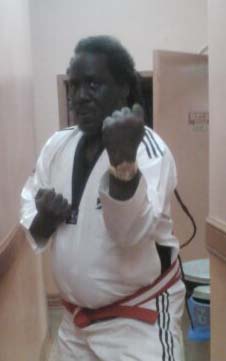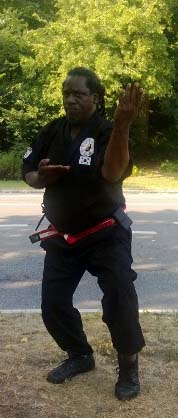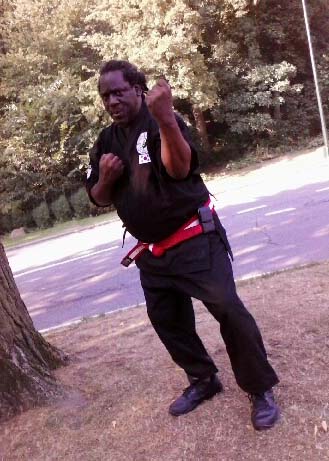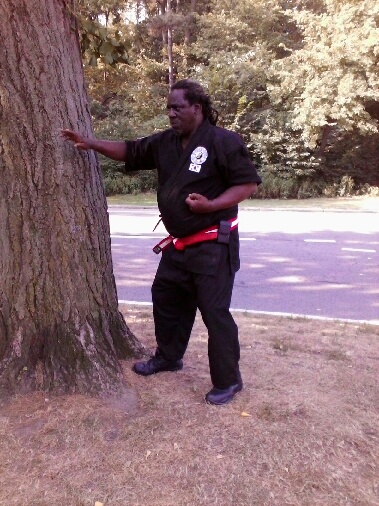MARTIALFORCE.COM
PRESENTS
AN INTERVIEW WITH
MAX LANE, SHIHAN
DEC / 2013
I reached Black Belt on or about 1972, under Abdul Mussawirr and Phil McRae
Many have trained in the Martial Arts and have made a name for themselves in competition, many have trained for a very long time and have made a name by their influence effected on others. Today I take great pleasure, and introduce a Martial Artist that has been around for a very long time, learning from luminaries in the Martial Arts, and forwarding the message of Karate as a Peaceful Art, and teaching principles that complete the individual not just the athlete.
Interview by Franklin Puello
Martialforce.com
Online Magazine
Martialforce.com: What is your full name, and where were you born?
MAX LANE: My Name is Maxwell Lane, Born in1941 Harlem, NY
Martialforce.com: What is your current occupation?
MAX LANE: Presently in the Sales industry
Martialforce.com: How did your enter your present Field?
MAX LANE: My student, Yussef Jihad, owns the clothing store Timeless Fashions 111 Lenox Avenue (between W. 115 and W. 116 Streets) New York City where I work. He facilitated my gainful employment. He also was the previous owner of the Dojo where I used to teach, in New Jersey, before it was closed.
Martialforce.com: When was your first introduction to the Martial Arts, What Style of Karate/ Kung Fu?
MAX LANE: First introduction was during 1961, In the Art of Jujitsu.
Martialforce.com: Who was/ were your first instructor/s?
I was introduced by my father, Elijah Maxwell Lane who was stationed in Okinawa during his service in the Army, where he started to study and train in the Martial Arts.
Martialforce.com: Why did he start teaching you?
He started training in Okinawa falling in love with the Arts; he then started teaching me and my sister specifically for self-defense purposes
Martialforce.com: Did you continue Training in the Martial Arts?
I then sought to continue training when about 1968 started training in the Bronx under Abdul Mussawirr and Phil McRae in the Art of Shotokan. Their Dojo was part of the Bronx Shotokan Karate Club. At the beginning it was just known as the Shotokan Karate Club and then the Bronx was added becoming BSKC. Eventually I also trained under your godfather known as “Dragon Kim”, Hung Kim in the Art of Warang Do
Martialforce.com: Which instructor has influenced you the most, and how? Would you describe their Teaching Philosophies and Methods of Teaching?
Mussawiir affected the greater influence in my Martial Arts, because the methodology of teaching was outstanding in reaching everyone. Hi has the uncanny ability to teach principles and skill simultaneously in such clear manner it was understood immediately and engrained in the students. His great knowledge of the Martial Arts was evident in his teaching, for he taught Principles and skills with explanations that showed the purpose in applications, as well as how these principles could be applied in every aspect of life.
Dragon Kim, as my godfather was also known as, influenced me in many ways as well. His direct methods of teaching and applicability made it easy to learn and apply principles and techniques.
Martialforce.com: Can you tell our readers what a typical day of training was like back when you were Training towards your Black Belt?
I reached Black Belt on or about 1972, under Mussawiir and McCrae, and the journey continues. Classes started with thorough warm ups, jumping jacks, pushups, sit ups, stretching and all necessary fitness skills to ensure safe engagement in the Karate activities. This was followed by Kihon- basic stances, blocks, punches, kicks; eventually leading to Kata training and sparring.Kata training was a serious phase. Kata was repetitive with corrections and refinements and continued until it became part of the students and could be performed in sleep.
Martialforce.com: What were the basic routine like during your Training?
The Class would start with the class lined up, Reishiki was a lesson repeated and mandated to be Mastered. The class learned how to respond to commands, line up properly, and show proper courtesy to the Dojo, the Teachers, and the other students. The Proper manner of Bow was taught and part of the everyday lessons. Then the class would warm up; go through training in Kihon techniques to set the strong foundations needed to graduate into the Kata. Kata was strained from the basic kata towards the advanced kata. The training sessions went for longer than 2 ˝ hours in a day when everyone was on their A game and not too many corrections were needed. The great teaching was apparent when the student’s progress was smooth and rapid, techniques became second nature and performances were near flawless.
Martialforce.com: Did you enter the Martial Arts competition Arena?
There was a time when I entered competition and 1975 thru 1977 I became part of the AAU headed by Chuck Merriman, Steinberg, and Lappupet.
Martialforce.com: What motivated you?
The main purpose of competition at that time was not just entering and wining a trophy, it was mostly testing and ensuring that the techniques trained were techniques that actually worked in combat
Martialforce.com: What was tournament competition like when you were first introduced?
Tournament competition was a fun part of the training where students were reminded of their training needs and what had to be improved. Tournaments organizations were different than present times. Most being like inter-dojo competitions and had many in-house referees, hence some were not judged as fairly as others but this did not deter from competition since the personal satisfaction of executing techniques that worked. I was disqualified several times for executing techniques that caused damage and blood was spilled, which was not an unusual occurrence or cause any hard feeling among competitors. . Many times slight injuries occurred on the competitors, but this did not deter anyone from continuing in competition neither did it create enemies. You got knocked down and learned to get up again, and again, and again developing a confidence unmatched and at the same time many Great friendships forged in the Heat and Fire of Battle.
Martialforce.com: When did you start teaching Karate?
Teaching has always been an important part of Karate training. The training is not just for the body but for the mind and spirit as well. The trained Karateka is required to practice and exhibit all skills learned and apply them to Life. Part of the mandate is to share with all those around you, meaning teaching it to as many as possible.
I started teaching as a Green Belt, because everyone during that time was learning the techniques to master, and in addition to be able to teach someone else.
Martialforce.com: Who helped you develop your teaching philosophy or your teaching Style?
Every student of Karate will start learning from his Teacher and many others around, including other students. In my case, the Principal were my teachers Abdul Mussawiir, Phil McRae, and Dragon Kim, they all who had very hard work ethics, and developed teaching skills to ease passing on their knowledge. They taught me persistence in my development and in demanding excellence while leading by example.
Martialforce.com: What Principles of the Martial Arts do you emphasize?
Respect and Courtesy, are first and paramount principles to be taught not only in the Martial Arts but in life, for when one learns to have respect for self then it reflects in the Respect given to others at all times. The same goes for being a courteous person, and that can mean that one is very keen about others’ feelings as well. Caring is another principle of great importance. One must love and respect self, others and the Art being taught, and at the same time have the Courtesy to understand and share with others in a respectful manner. The Care not only for what one does, Karate, but caring enough to pass on the knowledge, this is of great importance and is a lesson that must be taught.
Martialforce.com: Which of these Principles do you Teach as Life Skills?
All the above mentioned principles are taught as Life Skills, since Respect, Courtesy and Caring are not only demanded on the Dojo floor, but are expected and demanded to be practiced in everyday life among family, friends, at school, work or play.
The simple, but very complex Principle expressed by one of the definitions of “OSU”: Keep Pushing Ahead, Never Give Up. Teaching students that one must go forward in life trying to be the Best person one could be; that there may be many obstacles and disappointments to be met in life, but one should never give up but look for solutions and apply to situations to enable success and permitting forward progress. At the same time learning Courtesy that will enable one to share and help those around us succeed at the same time. This is the present principle of: No one is left behind.
Martialforce.com: Out of the many Elements of Karate, Why should a Martial Artist pay attention to Kata?
One of the reasons is that Kata is the essence of your fighting, once you learn your bunkai and train your combinations, and then all of those elements are brought into the fighting. All single techniques, are put into combinations for self-defense and fighting, Kata is the important element of Karate where all your techniques are put together to ease training all combinations and possibilities. Many do not give kata the importance it merits and it shows in their fighting, even some who get very good in fighting still show limitations and obvious weaknesses that make it easy for some opponents to defeat them It is useful and very important. Kata is an element of teaching that is used to train and practice a multitude of disciplines. It facilitates training of basics and their proper utilization in the growing steps towards further learning of more advanced techniques and applications. It also helps in developing a teaching plan, philosophy and teaching techniques. Being from the "Old" School we train Basics, Kata and bring it to Kumite.
Martialforce: What is your Most Favorite Kata? What makes it so Special?
MAX LANE: One is Bassai Dai- Penetrating the Fortress. It is special because the basic techniques mixed with the advanced movements dictate a total concentration and purpose in execution which results in efficiency, speed and applicability of the techniques
Martialforce.com: With that in mind, please share with our readers you thoughts about being a Complete Karateka?
MAX LANE: In remembering that one cannot build without proper and solid foundations, someone who shows knowledge of kihon, katas, and demonstrate sufficient skill, in addition to the proper respect and humility needed is to become a better person in the Dojo and community = A Complete Karateka.
Martialforce.com: What are some of the weapons you have mastered?
MAX LANE: Empty hand karate is what we were taught of old, and concentrated in developing and refining skills learned, but after many years I learned a bit of Kobudo, the art of mastering weapons. I learned and train with the Samurai, a bit of Sai, Bo Staff and small double edge blade which is a concealable blade the size of the palm of the hand.
Martialforce.com: What is your favorite Traditional Weapon?
MAX LANE: Among the many traditional weapons available at the time, I chose to train in the use of the Samurai. Because the weapon has its own spirit and contains the essence of Bushido
Martialforce.com: Do you Teach Weapons? At what stage or when are students taught Weapons?
MAX LANE: I do not teach weapons, but I consider certain students can make their own decision to learn Kobudo, and on the other hand I believe that some students should not be taught or allowed to enter a Kobudo class, if in my determination they aim to utilize the spirit of the weapons to harm others. I have always believe that the greater use of a weapon is in Never having to use it.
Martialforce.com: Are you presently training others in the Art of Self Defense? When did you make the transition, and why?
MAX LANE: I teach the self-defense aspect of the Martial Arts because it is an intricate part of the Arts. Self-defense is the most basic and intrinsic reason for the existence of the Martial Arts, with the Sport, Artistic expression and Health attached.
Martialforce.com: What do you teach those who want to learn Survival Skills?
MAX LANE: I start teaching basic self-defense and karate techniques application, graduating the students based on the length of time they spend with me with more advanced techniques. Their total development, physical and psychological, and moral character dictates their teaching, since self-defense techniques are not taught to those who may abuse its use.
Martialforce.com: What is your view of the present evolution of the Martial Arts and Teaching of the present and compare it to the past?
MAX LANE: Evolution has distanced the teaching methods and principles of old from how the Arts are taught in the present times. Teaching of principles and emphasis in Kata was of primary importance in the past with old teachers; present generations have evolved with emphasis in training as a “Sport”, teaching weak techniques and leaving out important principles of the martial arts that helped complete the growth of the individuals, as well as validating the efficiency of the techniques. The younger generation of so called Sensei have forgotten that Blocks are most times not really Blocks and Punches are not really Punches, where a high block may really be a forearm lifting the chin, or part of the motion of wrapping and locking the opponent’s arm, and a punch may be a wrist grab and twist in control.
Martialforce.com: I have known you for many years and watched you while attending competitions. Can you tell us about your relationship with some of the Masters and Grand Masters of the Past and Present?
MAX LANE: I hold great respect for many friends and teachers like Tiger Kim, Moses Powell, Thomas Lappupet, and Fred Miller, his brother Chester Miller, Abdul Mussawiir, Reno Morales, T. Taylor, Ron Van Clieff, Rico Guy, Karriem Abdalah, Haissan Kaleak, Papasan Canty, Lamar Thorton, Phil McRae, Derrick Williams, and Lil. KA or Kevin Thompson, special mention of a Franklin Puello, and youngsters Abdul Aziz, Gerald Harris. Felix Vasquez, Darrel Seargent among the many excellent teachers and friends in the great family of Karate Do. These great teachers teach the martial arts principles in a manner as prescribed which in turn molds the complete person, not just physically but most importantly mentally adding the spiritual growth to complement the whole.




